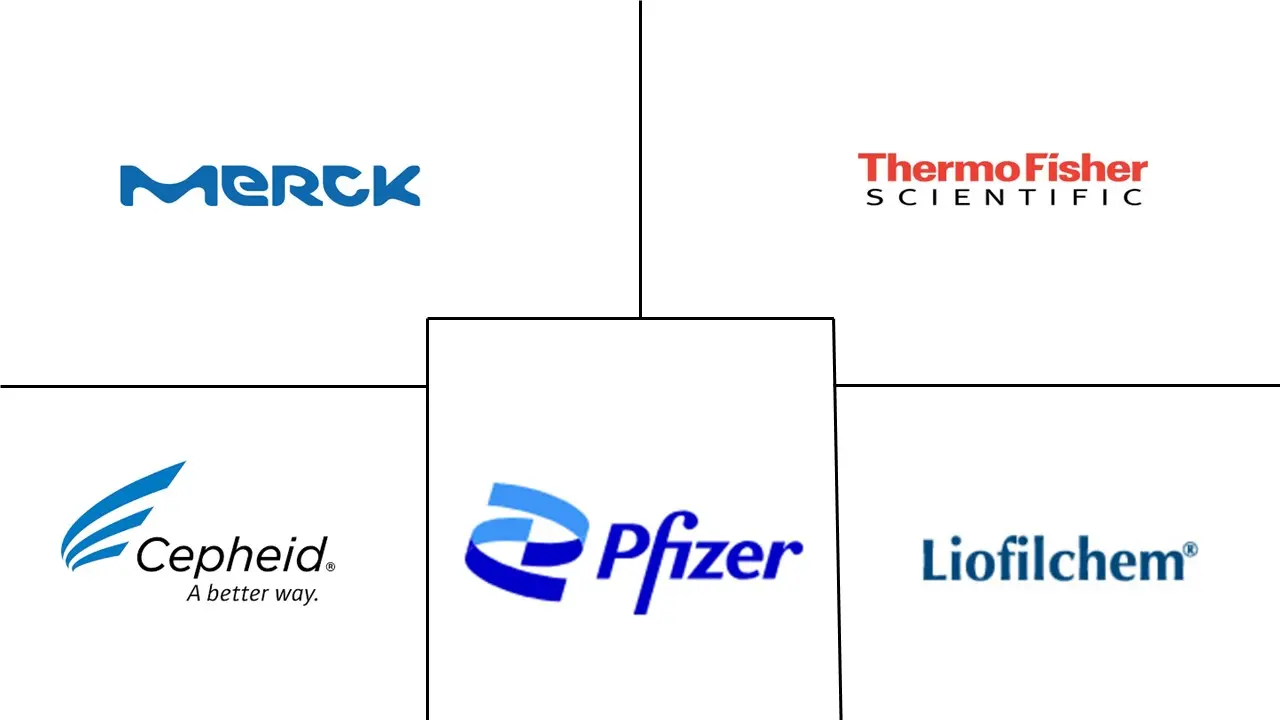Antimicrobial Resistance Surveillance Market Size and Share
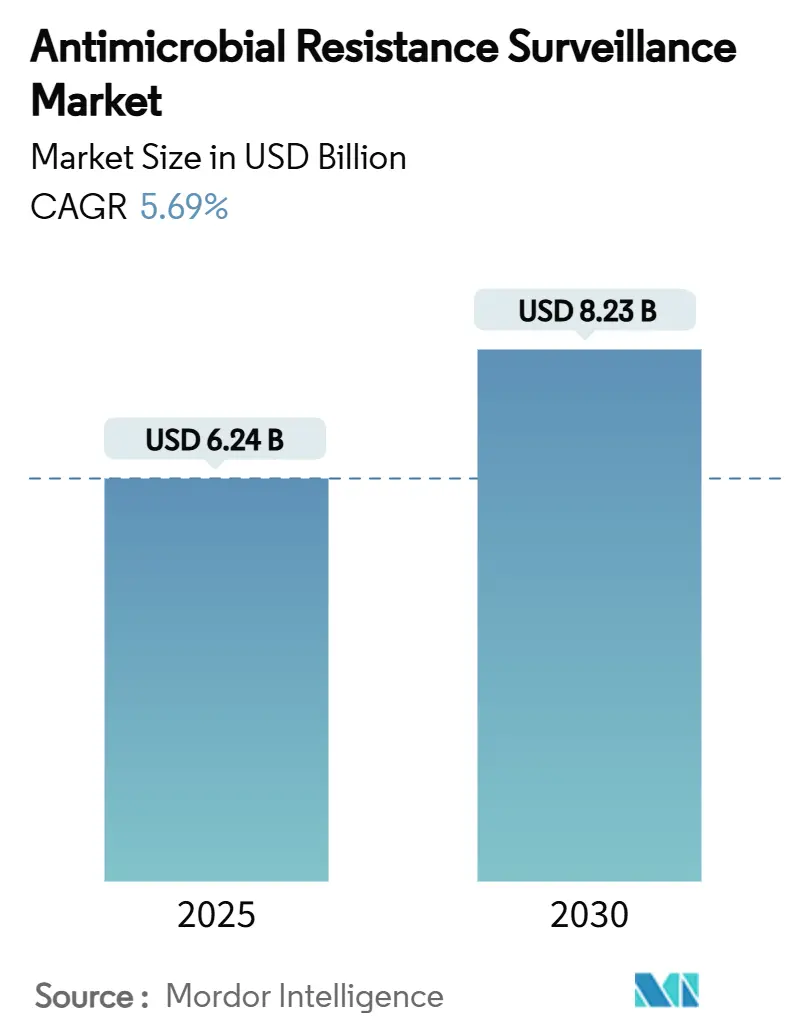
Antimicrobial Resistance Surveillance Market Analysis by Mordor Intelligence
The antimicrobial resistance surveillance market stands at USD 6.24 billion in 2025 and is forecast to reach USD 8.23 billion by 2030, progressing at a 5.69% CAGR during the period. Its growth reflects mounting global urgency to curb drug-resistant infections that claimed 4.95 million lives in 2019 and could kill 10 million annually by 2050 if left unchecked [1]World Health Organization, “Antimicrobial resistance,” who.int . Investments in AI-powered diagnostics, portable genomic sequencing, and real-time data platforms now shorten resistance detection from days to mere hours, improving treatment precision and outbreak control. North America accounts for 42.77% of current revenue, buoyed by nearly USD 650 million in federal funding since 2016 [2]Centers for Disease Control and Prevention, “AR Solutions Initiative,” cdc.gov , while Asia-Pacific leads growth at a 6.56% CAGR owing to regional digitization programs and integrated networks such as India’s i-AMRSS and China’s expanded national infrastructure. Consolidation among diagnostics majors and AI-centric start-ups intensifies competition as each side seeks scale advantages and technology differentiation.
Key Report Takeaways
- By solution, surveillance software held 42.22% of antimicrobial resistance surveillance market share in 2024, while surveillance services are poised for a 6.23% CAGR to 2030.
- By technology, molecular diagnostics contributed 38.98% revenue in 2024; AI and data-analytics platforms are set to grow at a 6.29% CAGR through 2030.
- By application, clinical diagnostics captured 54.29% share of the antimicrobial resistance surveillance market size in 2024, whereas pharma and biotech R&D will expand at a 6.34% CAGR by 2030.
- By end-user, hospitals and clinics accounted for 56.78% revenue in 2024; diagnostic laboratories are forecast to advance at a 6.39% CAGR over the same horizon.
- By geography, North America commanded 42.77% revenue in 2024; Asia-Pacific records the fastest 6.56% CAGR to 2030.
Global Antimicrobial Resistance Surveillance Market Trends and Insights
Drivers Impact Analysis
| Driver | (~)% Impact on CAGR Forecast | Geographic Relevance | Impact Timeline |
|---|---|---|---|
| Rising prevalence of drug-resistant infections | +1.2% | Global; highest in Asia-Pacific and Sub-Saharan Africa | Short term (≤ 2 years) |
| Government initiatives & funding | +0.9% | North America and EU, expanding to Asia-Pacific | Medium term (2-4 years) |
| Multi-drug resistance from antibiotic misuse | +0.8% | Global, especially in LMICs | Long term (≥ 4 years) |
| Accreditation-driven uptake of tracking tools | +0.6% | North America and EU with spillover to Asia-Pacific | Medium term (2-4 years) |
| AI-driven predictive analytics | +0.7% | Global, led by developed markets | Short term (≤ 2 years) |
| Portable genomic sequencers in the field | +0.5% | Asia-Pacific, Middle East & Africa, Latin America | Long term (≥ 4 years) |
| Source: Mordor Intelligence | |||
Rising Prevalence of Drug-Resistant Infections
Alarmingly high resistance rates reported across all WHO regions in 2024 continue to fuel the antimicrobial resistance surveillance market. Hypervirulent carbapenem-resistant Klebsiella pneumoniae sequence type 23 is now documented in 16 countries and infects both healthy and immunocompromised individuals, prompting urgent surveillance upgrades. Southeast Asian studies show carbapenem-resistant E. coli and Klebsiella in 8 and 9 of 11 nations respectively, with the heaviest burden in Indonesia, Philippines, Thailand, and Vietnam. The WHO forecasts 5.2 million deaths in the Western Pacific from AMR by 2030, with USD148 billion in economic losses, compelling health systems to invest in advanced monitoring.
Government Initiatives & Funding for AMR Programmes
The International Pathogen Surveillance Network introduced a USD4 million catalytic fund in 2024 to strengthen genomic monitoring in LMICs. The UK extended its real-time sequencing program with Oxford Nanopore from 10 to 30 NHS sites, redefining proactive outbreak response [3]Department of Health and Social Care, “Real-time pathogen surveillance,” gov.uk . In the United States, the draft PASTEUR Act allocates USD6 billion to antimicrobial innovation and CDC surveillance upgrades, while BARDA partners with Pattern Bioscience and BugSeq on AI-based diagnostics. FAO’s AMR multi-partner trust fund, active to 2030, underscores global coordination by supporting integrated surveillance across ten nations.
Emergence of Multi-Drug Resistance from Antibiotic Misuse
Systemic antibiotic misuse in humans, agriculture, and veterinary medicine accelerates multi-drug resistance beyond traditional detection capacity, pressing the antimicrobial resistance surveillance market to innovate. China’s per-capita antibiotic consumption still surpasses U.S. levels, reflecting widespread broad-spectrum overuse. WHO data highlight a tenfold gap between highest and lowest consuming nations, with many failing to meet the 70% ‘Access’ antibiotic target. Southeast Asian hospitals report aminopenicillins covering only 26% of neonatal sepsis cases, exposing urgent diagnostic gaps. AI-enabled platforms now predict resistance emergence from usage patterns, letting stewardship teams intervene before pathogens spread.
AI-Driven Predictive Analytics Adoption in AMR Platforms
Machine-learning models deliver >90% accuracy in resistance prediction directly from genomic data, slashing detection time to hours and reinforcing the antimicrobial resistance surveillance market. The FDA classified multiplexed cellular analysis systems as Class II devices in 2024, endorsing AI-enhanced diagnostics. T2 Biosystems now blends direct-from-blood PCR with AI decision support for real-time clinical guidance. Portable MinION sequencers tracked drug-resistant E. coli in Indonesian wastewater, illustrating field-ready surveillance.
Restraints Impact Analysis
| Restraint | (~)% Impact on CAGR Forecast | Geographic Relevance | Impact Timeline |
|---|---|---|---|
| High capital & operating cost | -0.8% | Global, especially in LMICs | Medium term (2-4 years) |
| Shortage of skilled microbiologists | -0.6% | Global; most severe in Sub-Saharan Africa and rural areas | Long term (≥ 4 years) |
| Cross-border genomic-data ethics | -0.4% | Global; highest impact in EU and Asia-Pacific | Medium term (2-4 years) |
| Lower awareness in developing regions | -0.3% | Asia-Pacific, Middle East & Africa, Latin America | Short term (≤ 2 years) |
| Source: Mordor Intelligence | |||
High Capital & Operating Cost of AMR Surveillance Systems
Whole-genome sequencing platforms can demand start-up investments topping USD 500,000, with ongoing reagent and maintenance costs near USD 200,000 per site annually, creating adoption hurdles in resource-constrained settings. Networked surveillance compounds expenses as multiple facilities integrate standardized protocols, data warehouses, and quality systems. The WHO now offers catalytic grants of USD 50,000–250,000 to LMIC projects, while developers explore paper-based sensors that satisfy REASSURED criteria at lower cost.
Shortage of Skilled Microbiologists & Bioinformaticians
Advanced surveillance platforms require scarce expertise in microbiology, bioinformatics, and analytics, leaving many regions understaffed. Rapid tech evolution heightens the training curve, and few academic programs can supply the needed workforce volume. WHO-backed regional training hubs tackle the gap, while automated analysis pipelines reduce hands-on demand and tele-education extends specialist support remotely.
Segment Analysis
By Solution: Software Dominance Drives Service Innovation
Surveillance software held 42.22% revenue in 2024, reflecting its central role in data orchestration across laboratories, hospitals, and public health agencies. Hospitals increasingly offload daily analytics, regulatory reporting, and compliance tasks to external experts, propelling surveillance services at a 6.23% CAGR. This shift toward managed solutions aligns with post-2024 FDA rules that heighten oversight of laboratory-developed tests and require continuous quality documentation, tasks that cloud-based providers handle at scale.
Growth in services signals broader movement from product sales to subscription revenue, enabling vendors to lock in long-term contracts and provide continuous algorithm updates. The antimicrobial resistance surveillance market benefits as AI modules, outbreak alerts, and regulatory dashboards integrate seamlessly within cloud environments, giving smaller hospitals sophisticated capabilities without large local IT footprints. bioMérieux’s acquisition of LUMED illustrates how diagnostics firms now marry hardware with stewardship software to deliver end-to-end offerings.
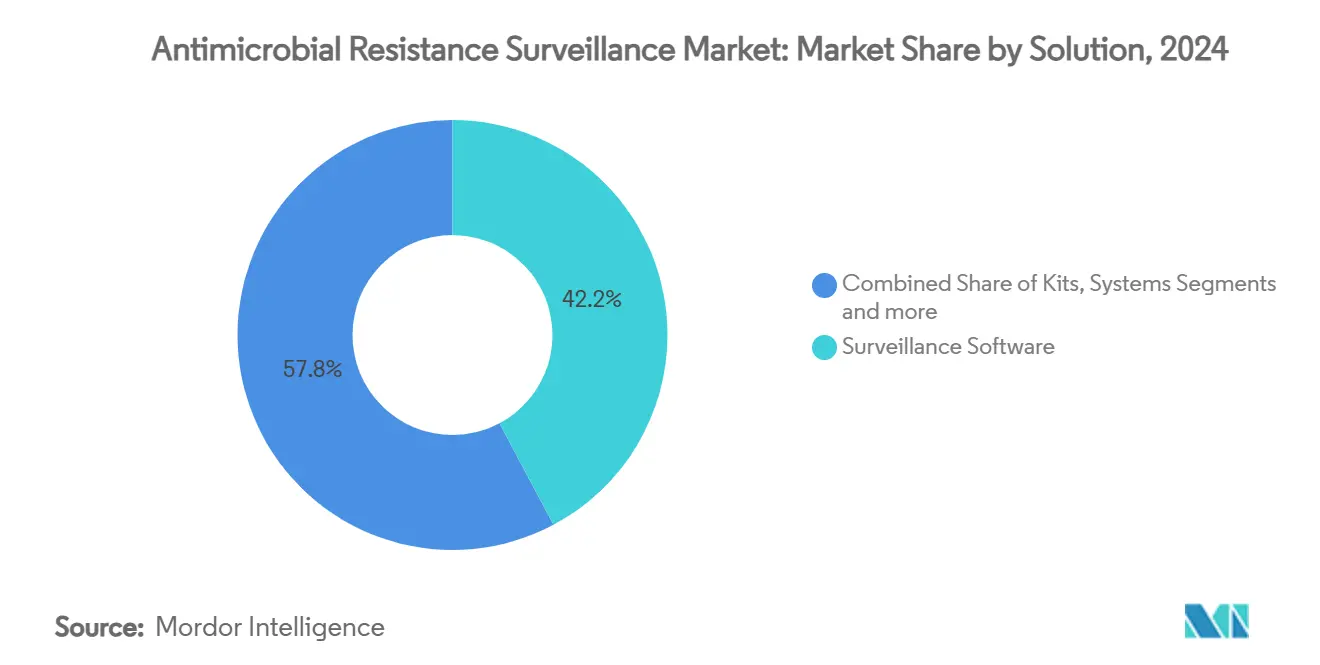
Note: Segment shares of all individual segments available upon report purchase
By Technology: AI Platforms Challenge Molecular Diagnostics Leadership
Molecular diagnostics commanded 38.98% of 2024 revenue as PCR and NGS methods offered rapid gene-based detection. Yet AI and data-analytics platforms are climbing fastest at 6.29% CAGR. These systems merge clinical, genomic, and epidemiological data to forecast resistance, a value proposition extending beyond laboratory walls. Integrated solutions that couple PCR detection with AI prediction now achieve >90% categorical agreement in susceptibility testing, positioning hybrids to erode the longstanding dominance of pure molecular workflows.
The antimicrobial resistance surveillance industry is witnessing portable sequencers such as Oxford Nanopore’s MinION that feed real-time reads into cloud AI engines for on-site decisions. Whole-genome sequencing remains a premium tool for cluster investigation, while culture-based and immunoassay methods retreat to niche roles where cost or infrastructure limit advanced options.
By Application: Clinical Diagnostics Leadership Faces R&D Disruption
Clinical diagnostics delivered 54.29% of 2024 revenue because patient management hinges on timely susceptibility data. However, pharma and biotech R&D, expanding at 6.34% CAGR, increasingly relies on high-resolution resistance profiling to de-risk drug discovery pipelines. Surveillance data now drive candidate selection, dosing strategies, and trial site targeting, embedding market analytics deep into drug development workflows.
The antimicrobial resistance surveillance industry also supports public health authorities that monitor regional trends to guide stewardship policies. Antimicrobial stewardship programs integrate surveillance dashboards to flag prescribing outliers, while environmental surveillance tracks agricultural runoff and wastewater for early warning of resistant strains.
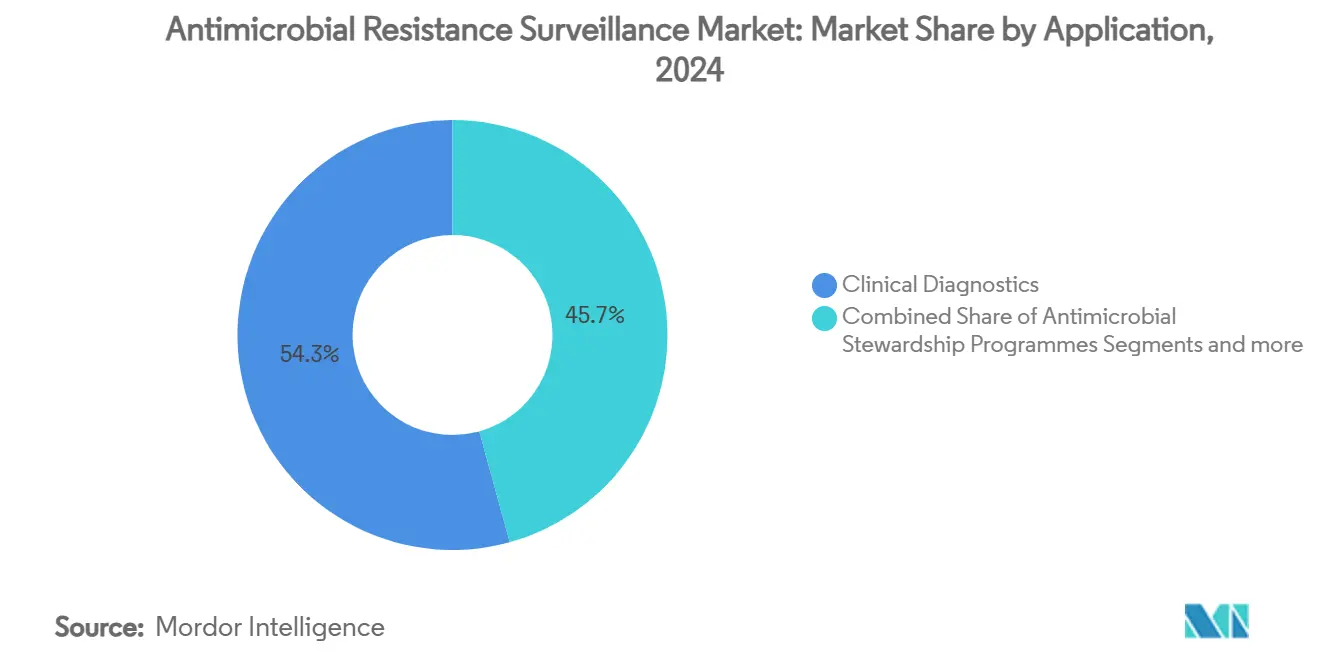
Note: Segment shares of all individual segments available upon report purchase
By End-User: Diagnostic Labs Challenge Hospital Dominance
Hospitals and clinics retained the largest share at 56.78% in 2024 due to point-of-care decision demands. Centralized diagnostic laboratories are the fastest-growing cohort, up 6.39% CAGR, as health systems outsource high-complexity testing. Large labs leverage economies of scale and automated workflows such as BD’s Phoenix-BDXpert-Synapsys suite to slash result turnaround and standardize quality.
The antimicrobial resistance surveillance market size for reference laboratories is set to expand as multisite networks seek uniform reporting formats, consolidated data lakes, and AI-powered epidemiological mapping. Academic centers and national reference labs remain critical for advanced genomic characterization, but private labs increasingly offer comparable services to regional hospitals under service-level agreements.
Geography Analysis
North America retains leadership with 42.77% revenue in 2024, backed by USD650 million in project funding through the CDC Antimicrobial Resistance Solutions Initiative and favorable FDA policies that accelerate diagnostic approvals. Continuous collaboration among CDC, BARDA, and industry sustains a robust pipeline of AI-enabled tools and integrated reporting platforms that feed directly into national dashboards for real-time situational awareness.
Asia-Pacific is the fastest-expanding territory at 6.56% CAGR as growing AMR burden prompts governments to digitize surveillance. China’s national networks, operational since 2005, now combine hospital and agricultural data while India’s i-AMRSS provides modular, open-source software to more than 100 sentinel sites. Regional joint funding between India and Japan accelerates applied research, while Singapore’s One-Health-aligned Roadmap integrates human, animal, and environmental inputs. Local private-public partnerships import portable sequencers and cloud analytics to underserved provinces, enlarging the antimicrobial resistance surveillance market.
Europe shows steady uptake supported by EU-wide surveillance frameworks that harmonize laboratory methods and enable rapid cross-border notification of emerging strains. Latin America, Middle East, and Africa remain nascent but gain momentum as WHO’s GLASS increases country participation to 92 and multi-partner grants finance early-stage network rollouts. In these regions, cost-efficient AI models paired with portable devices promise to leapfrog legacy infrastructure hurdles and expand the antimicrobial resistance surveillance market share among LMICs.
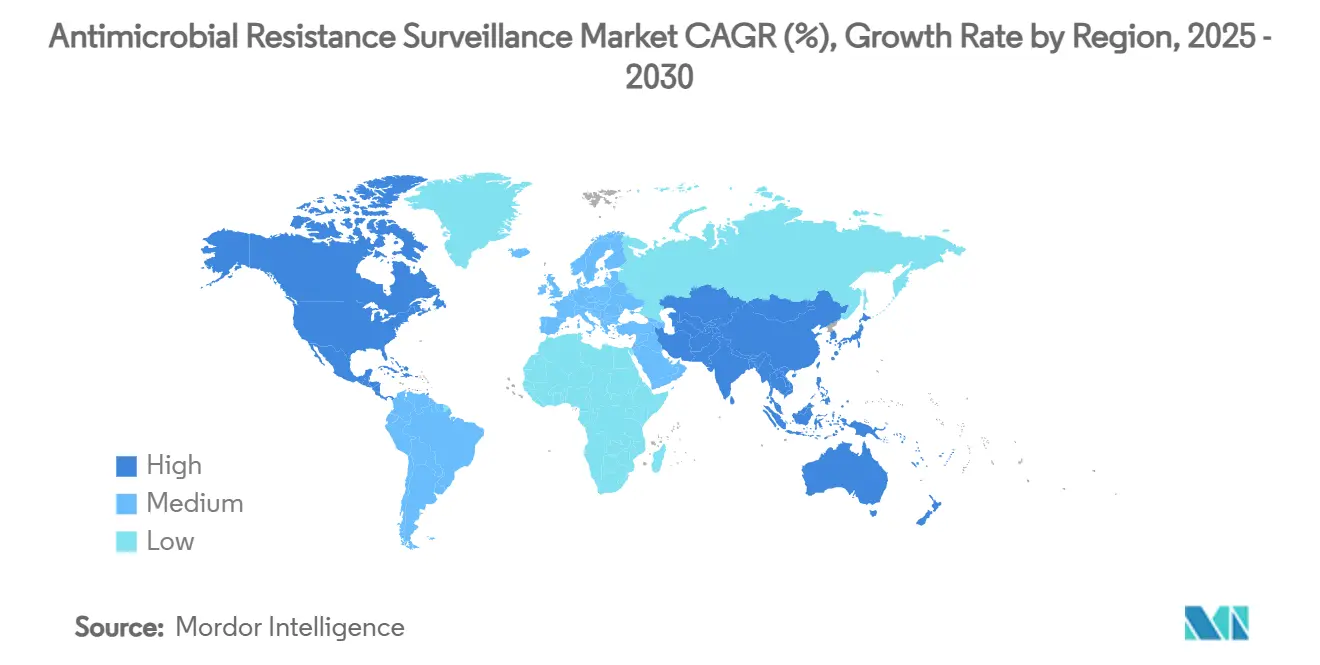
Competitive Landscape
The antimicrobial resistance surveillance market is moderately consolidated, with diagnostics giants leveraging scale, regulatory expertise, and global distribution. bioMérieux’s acquisition of LUMED brings stewardship algorithms into its core diagnostics business, while the Aurobac joint venture with Boehringer Ingelheim and Evotec channels EUR40 million into precision antimicrobials. Thermo Fisher and Roche complement hardware portfolios with cloud dashboards and automated susceptibility panels to lock in end-to-end customer relationships.
Becton Dickinson’s plan to spin off Biosciences and Diagnostic Solutions underscores management focus on infectious-disease tools with USD3.4 billion annual revenue, enabling sharper resource allocation to microbiology automation and informatics. Oxford Nanopore partners with UK NHS sites to integrate real-time sequencing and AI analytics, illustrating how co-development with health systems can accelerate adoption.
Emerging disruptors raise venture financing to target gaps in speed, cost, and portability. T2 Biosystems uses magnetic resonance to identify bloodstream pathogens in 3–5 hours. Day Zero Diagnostics secured USD 16 million to combine rapid NGS and in-house machine learning for same-day susceptibility predictions. These challengers often license their AI engines to incumbents, fostering a cooperative-competitive dynamic that accelerates market innovation while broadening the antimicrobial resistance surveillance market footprint.
Antimicrobial Resistance Surveillance Industry Leaders
-
Pfizer Inc.
-
Merck KgaA
-
Thermo Fisher Scientific
-
Cepheid
-
Liofilchem S.r.l.
- *Disclaimer: Major Players sorted in no particular order
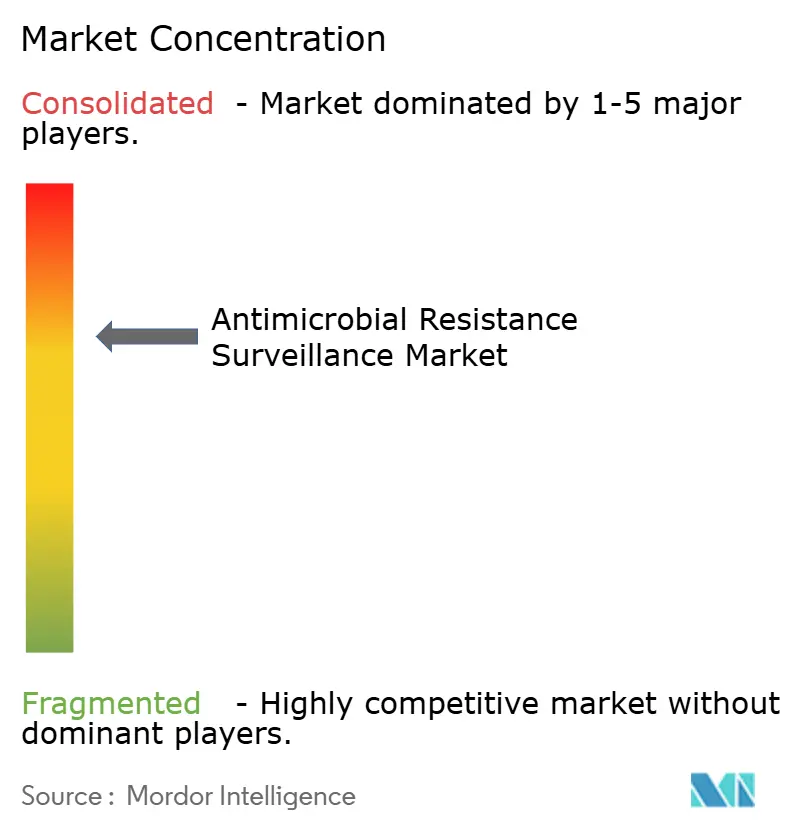
Recent Industry Developments
- February 2025: bioMérieux and the Embassy of France hosted “Rising to the Challenge: United Against Antimicrobial Resistance,” spotlighting diagnostics in stewardship efforts.
- February 2025: Becton Dickinson announced the separation of Biosciences and Diagnostic Solutions, creating a USD3.4 billion life-sciences tools specialist.
- January 2025: Roche obtained FDA clearance with CLIA waiver for cobas liat STI PCR tests that deliver results in 20 minutes.
- November 2024: UK Government expanded its Oxford Nanopore real-time surveillance network from 10 to 30 NHS sites for pandemic preparedness and AMR monitoring.
Global Antimicrobial Resistance Surveillance Market Report Scope
As per the scope of the report, antimicrobial resistance surveillance refers to the collection and analysis of antimicrobial resistance microbes’ data for the detection and monitoring of different infections caused by these agents.
The antimicrobial resistance surveillance market is segmented by solution (kits, systems, surveillance software, and surveillance services), application (clinical diagnostics, public health surveillance, and other applications), end user (hospitals and clinics, diagnostic centers, and other end-users), and geography (North America, Europe, Asia-Pacific, the Middle East and Africa, and South America).
The report offers the value (in USD) for the above segments.
The market report also covers the estimated market sizes and trends for 17 different countries across major regions globally.
| Kits |
| Systems |
| Surveillance Software |
| Surveillance Services |
| Culture-based Methods |
| Molecular Diagnostics |
| Whole-Genome Sequencing |
| AI and Data-Analytics Platforms |
| Others |
| Clinical Diagnostics |
| Public-Health Surveillance |
| Antimicrobial Stewardship Programmes |
| Pharma & Biotech R&D |
| Others |
| Hospitals and Clinics |
| Diagnostic Laboratories |
| Other End-Users |
| North America | United States |
| Canada | |
| Mexico | |
| Europe | Germany |
| United Kingdom | |
| France | |
| Italy | |
| Spain | |
| Rest of Europe | |
| Asia-Pacific | China |
| Japan | |
| India | |
| Australia | |
| South Korea | |
| Rest of Asia-Pacific | |
| Middle East and Africa | GCC |
| South Africa | |
| Rest of Middle East and Africa | |
| South America | Brazil |
| Argentina | |
| Rest of South America |
| By Solution | Kits | |
| Systems | ||
| Surveillance Software | ||
| Surveillance Services | ||
| By Technology | Culture-based Methods | |
| Molecular Diagnostics | ||
| Whole-Genome Sequencing | ||
| AI and Data-Analytics Platforms | ||
| Others | ||
| By Application | Clinical Diagnostics | |
| Public-Health Surveillance | ||
| Antimicrobial Stewardship Programmes | ||
| Pharma & Biotech R&D | ||
| Others | ||
| By End-User | Hospitals and Clinics | |
| Diagnostic Laboratories | ||
| Other End-Users | ||
| By Geography | North America | United States |
| Canada | ||
| Mexico | ||
| Europe | Germany | |
| United Kingdom | ||
| France | ||
| Italy | ||
| Spain | ||
| Rest of Europe | ||
| Asia-Pacific | China | |
| Japan | ||
| India | ||
| Australia | ||
| South Korea | ||
| Rest of Asia-Pacific | ||
| Middle East and Africa | GCC | |
| South Africa | ||
| Rest of Middle East and Africa | ||
| South America | Brazil | |
| Argentina | ||
| Rest of South America | ||
Key Questions Answered in the Report
What is the current size of the antimicrobial resistance surveillance market?
The antimicrobial resistance surveillance market is valued at USD 6.24 billion in 2025 and is projected to reach USD 8.23 billion by 2030.
Which region leads the antimicrobial resistance surveillance market?
North America leads with 42.77% revenue in 2024, supported by large federal investments and advanced healthcare infrastructure.
Which segment is growing fastest within the antimicrobial resistance surveillance market?
Surveillance services are expanding fastest at a 6.23% CAGR as hospitals prefer turnkey managed solutions.
Why is Asia-Pacific the fastest-growing region?
Asia-Pacific posts a 6.56% CAGR thanks to rising AMR burden, government digitization programs, and growing investment in integrated surveillance networks.
Asia-Pacific posts a 6.56% CAGR thanks to rising AMR burden, government digitization programs, and growing investment in integrated surveillance networks.
AI platforms cut detection from days to hours, achieve >90% accuracy in resistance prediction, and integrate multi-modal data for real-time clinical decision support.
What are the main challenges limiting adoption?
High capital costs, shortage of skilled microbiologists and bioinformaticians, and data-sharing ethics across borders remain key hurdles, particularly in low- and middle-income countries.
Page last updated on:
